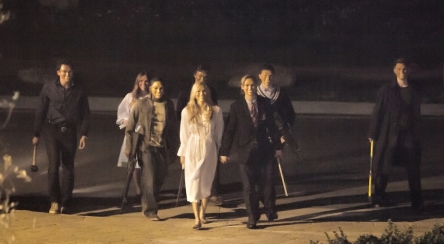After my first pre-viewing movie review, I received a request to pre-review™ the new Ethan Hawke film, The Purge. As is my method, I have not seen this film. After reading this pre-review, I may not want to see it, either.
The Purge stars Hawke, a movie star of sorts. He was excellent in Training Day as a naive PCP-smoking cop who concludes his first day in Narcotics by shooting Denzel Washington in the ass. He’s also been in other films, although I’m at a total loss to name one. He was married to Uma Thurman at one point. Uma is one of those people who looks much better in photos than live action, sort of like Gwyneth Paltrow. Anyway, Hawke has to be a star if Uma married him.
The Purge is directed by James DeMonaco, of whom know I almost nothing. According to the Internet Movie Database, he wrote The Negotiator, which I really liked. He also wrote Jack, an atrocious film starring Robin Williams. Jack centered around the humorous tale of a kid with some fast-aging disease. Funny stuff. How bad was it? Diane Lane is in it, and I didn’t even care. Inexplicably, it was directed by Francis Ford Coppola at what had to be the nadir of his career. Imagine Martin Scorcese directing an Ace Venture sequel and you get the point. Oh, Jack was produced by Fred Fuchs. That figures.
If I understand the trailer, The Purge is set is the near-future–I know that because there are no space ships and people aren’t wearing jumpsuits. Unemployment and crime are at all-time lows because of the “Purge.” During the Purge nothing is illegal and all emergency services are cancelled. You can just run wild and kill people. Most of the action looks like it takes place at night. The movie poster says that it lasts 12 hours–the Purge, not the film (hopefully).
The Purge is some kind of cathartic exercise which keeps the country calm the rest of the year. Don’t buy the hype that this is an “original” idea. My best friend growing up–Jimmy–had this idea first. When we were in high school, Jimmy wanted one day a year when we could just kill anyone we wanted. He theorized that we had so much violence in our home county because, if you hated someone, there was no way to avoid that person. Eventually, something had to give. So, this idea isn’t original. As an unrelated aside, he also suggested replacing the electric chair with “death by bear trap,” where the condemned would be thrown into a pit full of bear traps. Jimmy thought that would be more humane. That’s questionable, but I still consider him to be the Father of Lethal Injection.
Hawke is the father of a nice, normal-looking family. They lock down their house during the Purge and wait it out. Some dude gets in their house right before lock down and other marauders terrorize the family during the Purge. Michael Bay produced this film, so there are probably a lot of explosions.
Here’s what’s bound to happen. This hapless interloper is probably not that bad guy, although the Hawke family is terrified of him. They debate throwing him to the mob or maybe just killing him themselves. They might even try to kill each other. Lots of stuff happens–attacks, injuries, killings, etc. Eventually, Hawke realizes that his nice little family isn’t much different from the bloodthirsty goons on the street. Other stuff happens and the movie ends. Important lessons are learned about the true nature of humans.
The bad guys wear masks, but I can’t figure out why. I thought everything was legal. Why the masks? I guess that just makes them scarier. Without seeing the film, it’s hard to say, really.
I must praise Hawke’s performance here. Normally, he portrays a disheveled, grungy-looking guy in need of a close shave and a good conditioner. From what I can tell, he’s pretty clean-cut here. That’s a stretch for him, and one must respect that. On the downside, he’s still kind of squinty-eyed and fairly incomprehensible when he talks.
Looking at the cast for the film, I note that one character is named “Zoey.” This is an obvious and shameless attempt to deceive the public into believing that Zooey Deschanel is in this film. She is not–or at least she isn’t in the credits. So, don’t go to this film expecting to see the charming and beguiling Zooey. Shame on Michael Bay for engaging in such fraud in order to sell a film.
It also should be noted that Julianne Hough is not in this film. I like her and want her in more films–every film, in fact. How hard would it have been to write a dancing scene? If you’re locked down all night, you’d get bored. Dancing would be a good way to kill time.
I have to ask a question about the plot: Why the hell would this Purge work? I grew up in Harlan County, Kentucky, where we were in a state of almost constant Purge, and it didn’t seem to help crime OR unemployment. If people go bat-shit crazy for 12 hours, do they just calm down afterwards? Maybe there is some kind of Draconian police state that takes care of that. If so, why even have the Purge? The whole thing seems rife with problems. It’s just not realistic.
It’s a close call, but I can’t recommend The Purge. On the one hand, I am pleased to see my friend’s idea come to the Big Screen some 35 years after the fact. On the other hand, I haven’t seen the film, so there’s that. Ethan Hawke is a plus, because of Training Day–I like all films starring Denzel Washington. Characters such as “Bloody Stranger” and “Interrupting Freak” are intriguing, too. But, there’s Jack to consider, too.
I give The Purge a 4.25.
©thetrivialtroll.wordpress.com










